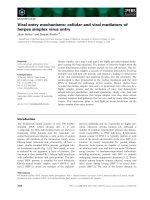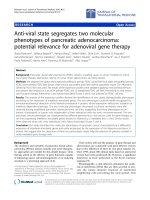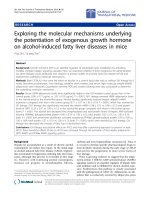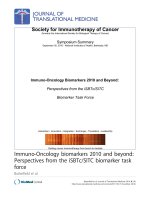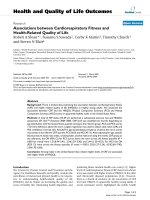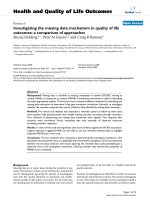Báo cáo hóa học: " Aqueous Solution Preparation, Structure, and Magnetic Properties of Nano-Granular ZnxFe32xO4 Ferrite Films" potx
Bạn đang xem bản rút gọn của tài liệu. Xem và tải ngay bản đầy đủ của tài liệu tại đây (535.57 KB, 6 trang )
NANO EXPRESS
Aqueous Solution Preparation, Structure, and Magnetic
Properties of Nano-Granular Zn
x
Fe
32x
O
4
Ferrite Films
Qiang Tian
•
Qian Wang
•
Qingshui Xie
•
Jiangong Li
Received: 11 March 2010 / Accepted: 7 June 2010 / Published online: 22 June 2010
Ó The Author(s) 2010. This article is published with open access at Springerlink.com
Abstract This paper reports a simple and novel process
for preparing nano-granular Zn
x
Fe
3-x
O
4
ferrite films
(0 B x B 0.99) on Ag-coated glass substrates in DMAB-
Fe(NO
3
)
3
-Zn(NO
3
)
2
solutions. The deposition process may
be applied in preparing other cations-doped spinel ferrite
films. The Zn content x in the Zn
x
Fe
3-x
O
4
films depends
linearly on the Zn
2?
ion concentration ranging from 0.0 to
1.0 mM in the aqueous solutions. With x increasing from 0
to 0.99, the lattice constant increases from 0.8399 to
0.8464 nm; and the microstructure of the films changes
from the non-uniform nano-granules to the fine and uni-
form nano-granules of 50–60 nm in size. The saturation
magnetization of the films first increases from 75 emu/g to
the maximum 108 emu/g with x increasing from 0 to 0.33
and then decreases monotonously to 5 emu/g with x
increasing from 0.33 to 0.99. Meanwhile, the coercive
force decreases monotonously from 116 to 13 Oe.
Keywords Ferrite films Á Aqueous solution deposition Á
Nano-granules Á Magnetic properties
Introduction
Spinel ferrites, Me
x
Fe
3-x
O
4
(Me = Mn, Co, Ni, Zn, Mg,
Cu, etc.), are a technologically important group of mate-
rials, having numerous applications in magnetic devices,
recording materials, photocatalysis, ferrofluid technology,
magnetic refrigeration, and humidity sensors [1, 2]. The
typical spinel ferrite, Fe
3
O
4
, has 64 tetrahedral sites (A
sites) and 32 octahedral sites (B sites) of which only 8 A
sites and 16 B sites are occupied by the Fe
2?
and Fe
3?
ions,
respectively. The inverse nature of this spinel implies that
all the A sites are occupied by Fe
3?
ions, while an equal
number of Fe
2?
ions and Fe
3?
ions share the B sites [3].
Structural and magnetic properties of spinel ferrites
MeFe
2
O
4
strongly depend upon the nature, concentration,
and distribution of the substituted Me cations on A and B
sites as well as the method of preparation. If the depen-
dence of physical properties on substituted cations is
known for a given complex ferrite, then it is possible to
design a ferrite possessing the desired physical properties
by choosing the appropriate compositions.
In recent years, the Zn- or NiZn- incorporated ferrite
films with high resistivity and high permeability are widely
used in micro-inductors, micro-transformers, magnetic
recording, and high-frequency field [4]. For example, if the
electronic circuits are covered with the NiZn ferrite film,
the magnetic films render additional resistance to the cir-
cuits, thus attenuating the conducted-electromagnetic
noises [5]. Fujiwara et al. studied the Zn
2?
ions-doped
ferrite films having high real part (l
0
) and imaginary part
(l
00
) of permeability in 10 to 100 MHz region. The films
may be used as high-frequency magnetic film devices that
are required at present for the current information tech-
nology infrastructure development [6]. Zn
x
Fe
3-x
O
4
ferrite
films were applied to field effect spintronic devices pre-
pared by a pulsed-laser deposition technique [7].
Various preparation techniques such as liquid phase
epitaxy, sputtering, plasma splay, and molecular beam
epitaxy have been employed for preparing ferrite films. In
all these processes, post-heat treatments or high deposition
Qiang Tian and Qian Wang contributed equally to this work.
Q. Tian Á Q. Wang Á Q. Xie Á J. Li (&)
Institute of Materials Science and Engineering and MOE Key
Laboratory for Magnetism and Magnetic Materials, Lanzhou
University, 730000 Lanzhou, China
e-mail:
123
Nanoscale Res Lett (2010) 5:1518–1523
DOI 10.1007/s11671-010-9672-4
temperatures ([600°C) are required to induce the desired
crystalline phases [8]. The high temperature would
deteriorate the non-heat-resistant substrates, e.g., GaAs
integrated circuits, plastics, and biomaterials [9]. The low-
temperature wet chemical preparation methods such as spin
spray plating [10], electrodeposition [11], and chemical
deposition [12] offer a good alternative as it can overcome
the drawbacks of the conventional methods. Abe et al. [13]
developed a widely used spin spray method. In the process,
long deposition time and complex equipment are needed;
and a great deal of reactants is wasted. Recently, Izaki
developed a very simple method to prepare magnetite and
Zn-incorporated magnetite film by immersing a Pd/Ag-
catalyzed substrate in the stable aqueous nitrate and
dimethylamine borane complex (DMAB) solution [14, 15].
In Izaki’s method, the incorporation of Zn into magnetite
was finished by the deposition of magnetite film on ZnO
thin film, so the Zn content of ferrite film and the magnetic
properties cannot be well adjusted.
In order to overcome the drawbacks of the above-
mentioned methods, a modified Izaki’s method was
used to prepare nanostructured Zn
x
Fe
3-x
O
4
ferrite films
(0 B x B 0.99) on Ag-coated glass substrates in the DMAB-
Fe(NO
3
)
3
-Zn(NO
3
)
2
solutions at 80° C by adjusting the
Zn(NO
3
)
2
concentration. The dependence of structure and
magnetic properties of the Zn
x
Fe
3-x
O
4
ferrite films on the Zn
content was studied.
Experimental Section
Prior to deposition, glass substrates were cleaned ultra-
sonically in ethanol and acetone for removing organic
impurities and rinsed in distilled water. Then Ag layer was
deposited on the glass substrates (24 9 12 9 0.5 mm)
using a two-step Sn/Ag activation process at room tem-
perature. This two-step Sn/Ag activation process includes
sensitizing the glass substrates by dipping in solution
containing 10 g/l SnCl
2
and 0.08 M HCl, rinsing the sub-
strates by distilled water, and activating the glass substrates
by 1–2 g/l AgNO
3
. The above steps were repeated three to
six times to form Ag nano-granules with small sizes and a
high density over the entire substrate surface. The Zn
x
Fe
3-x
O
4
ferrite films (0 B x B 0.99) were prepared by immersing
the Ag-catalyzed substrates in a 50-ml tube containing
15 mM iron nitrate 9-hydrate, 0–1.4 mM zinc nitrate
hexahydrate, and 30 mM DMAB at 80°Cfor1h.
The pH values of the mixed solutions were measured by
using a PHS-29A meter (Shanghai Precision Scientific
Instrument Co.). X-ray diffraction (XRD) patterns of the
films were measured using a Rigaku D/Max-2400 X-ray
diffractometer with Cu K
a
radiation (40 kV, 60 mA). The
average grain sizes of the films were estimated from the
diffraction peak widths through Scherrer equation. For the
Rietveld refinements, the XRD data were recorded in a
range from 15 to 90° (2h) with a step width of 0.02° and a
counting time of 3 s per step. The chemical compositions
of the films were analyzed by a Thermo IRIS Advantage
inductively coupled plasma atomic emission spectrometer
(ICP-AES). The morphology and thickness of the films
were analyzed by a Hitachi S-4800 field emission scanning
electron microscope (SEM). The Raman spectra were
recorded on the Horiba Jobin–Yvon LABRAM-HR800
laser micro-Raman spectrometer with 532-nm radiation
that provides a typical spatial resolution less than 1 lm and
spectral resolution better than 1 cm
-1
in peak position. The
magnetic properties of the films were measured at room
temperature by a Lake Shore 7304 vibrating sample mag-
netometer (VSM).
Results and Discussion
No ferrite film could be deposited on the bare glass sub-
strates under the same reaction conditions. So the Ag layer
plays an important role in deposition of the ferrite films.
The preparation of the Ag-catalyzed substrates can be
formulated briefly as follows:
Sn
2þ
þ 2Ag
þ
¼ Sn
4þ
þ 2Ag #ð1Þ
The deposition of the ferrite film can be formulated briefly
as follows: [8, 15, 16]
ðCH
3
Þ
2
NHBH
3
þ 3H
2
O þH
þ
!ðCH
3
Þ
2
NH
þ
2
þ H
3
BO
3
þ 3H
2
"; ð2Þ
ðCH
3
Þ
2
NHBH
3
þ 3H
2
O !ðCH
3
Þ
2
NH
þ
2
þ H
3
BO
3
þ 5H
þ
þ 6e;
ð3Þ
NO
À
3
þ H
2
O þ2e ! NO
À
2
þ 2OH
À
; ð4Þ
Fe
3þ
þ e ! Fe
2þ
; ð5Þ
xFe
2þ
þyFe
3þ
þzZn
2þ
+ 8OH
À
!ðFe
2þ
; Fe
3þ
; Zn
2þ
Þ
3
OHðÞ
8
ðx þy þz ¼ 3Þ; ð6Þ
ðFe
2þ
; Fe
3þ
; Zn
2þ
Þ
3
OHðÞ
8
!ðFe
2þ
; Fe
3þ
; Zn
2þ
Þ
3
O
4
þ 4H
2
O: ð7Þ
The pH value increases from 2.2 to 4.2 in the first
20 min and subsequently decreases slightly in the range
from 4.2 to 3.9. At the beginning of the reaction, the low
pH value (pH = 2.2) is caused by the hydrolyzation of
Fe
3?
.TheH
?
ions are rapidly reduced to H
2
, and DMAB is
oxidized to weak basic dimethylamine according to Eq. 2.
The NO
À
3
ions are also reduced to NO
À
2
ions, giving rise to
an increase in the OH
-
concentration and an increase in the
pH value of the solution to 4.2 (Eq. 4). With the progress of
the reaction, the OH
-
ions and metal cations are consumed
Nanoscale Res Lett (2010) 5:1518–1523 1519
123
gradually (Eq. 6), which leads to a slight decrease in pH
value from 4.2 to 3.9. However, the magnetite grows only
at pH [ 7 according to the potential-pH equilibrium
diagram for the iron-water system at 25°C[17]. Homma
et al. [18] found that the oxidation of DMAB preferably
proceeded in the electric double layer at the surface region
of the catalyzed metal; and the catalytic activity of the
deposited metal was caused by its electron acceptivity. The
hydrolyzed metal ions migrate to the surface of the Ag
layer mediated by the electrostatic force, and the
dehydration reaction is accompanied by the reactions of
Eqs. 6 and 7. The reduction of NO
À
3
ions to NO
À
2
ions is
accelerated at the surface of the Ag layer, which is the key
to raising the local pH value. Therefore, the ferrite films
can form at a weak acid solution. In addition, as shown in
Fig. 1, the Ag-catalyzed layer on the glass substrates is
composed of fine Ag nano-granules of 1–10 nm in size.
The surface of the Ag layer possesses the large surface area
of the fine Ag nano-granules. Heterogeneous nucleation is
promoted by the presence of the Ag nano-granules on the
glass substrates and energetically more favorable due to the
high surface energy of the large surface area of the fine Ag
nano-granules. The nucleation may take place at a lower
saturation ratio on the Ag-catalyzed substrates than in
solution.
The compositions of the prepared Zn
x
Fe
3-x
O
4
films
were determined by ICP-AES measurement. The Zn con-
tents x in the Zn
x
Fe
3-x
O
4
films prepared with the Zn(NO
3
)
2
concentrations of 0, 0.1, 0.25, 0.4, 0.6, 0.8, 1.0, and
1.2 mM in solution are 0, 0.12, 0.33, 0.41, 0.64, 0.77, 0.96,
and 0.99, respectively. Meanwhile, the Fe content in the
films decreases from 3 to 2.01 as x increases from 0 to 0.99.
The Zn content x in the Zn
x
Fe
3-x
O
4
films depends linearly
on the Zn
2?
ion concentration ranging from 0.0 to 1.0 mM
in the solutions, as shown in Fig. 2. This is helpful for
preparing Zn ferrite films with desired Zn contents. The
impurities (mainly B) in the Zn
x
Fe
3-x
O
4
ferrite films are
less than 0.05 wt%.
Figure 3 shows the XRD patterns of the Zn
x
Fe
3-x
O
4
ferrite films with the x values of 0, 0.12, 0.41, 0.77, and
0.99. All the observed diffraction peaks can be indexed as
the (111), (220), (311), (400), (422), (511), and (440) dif-
fractions of the cubic spinel phase [3, 19]; and no addi-
tional diffraction peaks of any other phases are detected.
The diffraction peaks in the XRD patterns of all the films
are broader compared to the coarse-grained spinel, indi-
cating that the grains of the ferrite films are fine. The
average grain sizes of the Zn
x
Fe
3-x
O
4
films with the x
values of 0, 0.12, 0.41, 0.77, and 0.99 estimated using
Scherrer formula from the widths of the diffraction peaks
are 47, 44, 49, 45, and 32 nm, respectively. All diffraction
peaks in the XRD patterns shift slightly toward low angles
with increasing Zn content, indicating that the lattice
constant of the Zn
x
Fe
3-x
O
4
films increases with increasing
Zn content. The lattice constants for the films with different
Zn contents determined by the Rietveld refinements are
shown in Fig. 4. The lattice constant increases from 0.8399
Fig. 1 The SEM micrograph of the Ag-catalyzed substrate surface
Fig. 2 The dependence of the zinc content x in the films on the zinc
ion concentration in the solutions
Fig. 3 The XRD patterns of the Zn
x
Fe
3-x
O
4
ferrite films with x = 0,
0.12, 0.41, 0.77, and 0.99
1520 Nanoscale Res Lett (2010) 5:1518–1523
123
to 0.8464 nm as x increases from 0 to 0.99. This result is
similar to the Zn ferrites and NiZn ferrites prepared by
pulsed-laser deposition and sol–gel method [7, 20]. It may
be understood by considering that the ionic radius of Zn
2?
(0.074 nm) is larger than the ionic radius of Fe
3?
(0.064 nm) [21, 22]. The incorporation of larger ions into
the lattice of the films would expand the lattice and
increase the lattice constant.
The Fe
3
O
4
film was composed of nano-granules
10–250 nm in size (Fig. 5a). The Zn
0.41
Fe
2.59
O
4
and
Zn
0.99
Fe
2.01
O
4
ferrite films are composed of uniform
equiaxed nano-granules of about 50–60 nm in size
(Fig. 5b, c). This indicates that the incorporation of Zn
2?
ions into the ferrite films leads to the formation of fine and
uniform nano-granules. The Zn
0.41
Fe
2.59
O
4
ferrite film has
a slightly rough surface with a thickness of about 300 nm
(Fig. 5d). The nano-granular microstructure of the depos-
ited ferrite films may result from the random nucleation of
the ferrite granules on the nano-granular surface of the Ag
catalyzed layer on the glass substrates (Fig. 1). However,
for the spin spray method, the smooth bare glass was
directly used as the reaction substrates that can facilitate
the nucleation and growth of ferrite grains to columnar
microstructure [6].
The magnetite (Fe
3
O
4
) has a cubic structure belonging
to the space group O
h
7
(Fd3 m). Theoretical analysis for the
spinel ferrite showed that there are five Raman-active
modes (A
1g
? E
g
? 3T
2g
) that involve mainly the motion
of the O ions and both the O and the ions in A sites and do
not contain the vibration of the ions in B sites at all [23,
24]. Figure 5 shows the Raman spectra measured at 293 K
for the Fe
3
O
4
,Zn
0.41
Fe
2.59
O
4
, and Zn
0.77
Fe
2.23
O
4
films.
There are three obvious Raman-active modes at about 302,
535, and 671 cm
-1
for the Fe
3
O
4
film, and other two
Raman-active modes are absent. This result is in agreement
with the reported studies [25]. In the cubic spinels
including ferrites, the modes at above 600 cm
-1
are of the
A
1g
type, mostly corresponding to the motion of oxygen in
tetrahedral AO
4
groups. With increasing Zn content, the
Raman mode around 680 cm
-1
becomes broad and shifts
slightly toward high frequency as shown in Fig. 6. The
Raman mode at 680 cm
-1
for the Zn
0.77
Fe
2.23
O
4
film was
fitted by two Gauss peaks with the peak positions at 653
and 681 cm
-1
. The mode for the Zn
0.41
Fe
2.59
O
4
film was
fitted by two peaks at 648 and 679 cm
-1
. In fact, the
Raman modes at 653 and 648 cm
-1
are ascribed to the
oxygen breathing vibrations against zinc; and the 681 and
Fig. 4 The lattice constant a of the Zn
x
Fe
3-x
O
4
ferrite films in
variation of the Zn content x
Fig. 5 The top view SEM
micrographs of the Fe
3
O
4
(a),
Zn
0.41
Fe
2.59
O
4
(b), and
Zn
0.99
Fe
2.01
O
4
(c) ferrite films
as well as the cross-sectional
SEM image of the
Zn
0.41
Fe
2.59
O
4
ferrite film (d)
Nanoscale Res Lett (2010) 5:1518–1523 1521
123
679 cm
-1
modes are due to corresponding oxygen vibra-
tions against iron [23]. So the observation of the broad
mode at around 680 cm
-1
can be the result of the coexis-
tence of FeO
4
and ZnO
4
groups [4]. In addition, the
intensity ratio of the ZnO
4
vibration to the FeO
4
vibration
increases with increasing Zn content. Hence, more Zn
2?
ions are incorporated into the A sites with increasing x for
Zn
x
Fe
3-x
O
4
.
The saturation magnetization M
s
increases with x
increasing from 0 to 0.33, reaches a maximum value of
108 emu/g at x = 0.33, and then decreases to 5 emu/g with
x further increasing from 0.33 to 0.99 as shown in Fig. 7.
The M
s
of the Zn
x
Fe
3-x
O
4
film samples prepared by spin
spray method increases with increasing x, reaches a max-
imum value of 110 emu/g at x & 0.25, and then decreases
with further increase in x [6]. The variation of the M
s
of the
Zn
x
Fe
3-x
O
4
ferrite films can be attributed to the ion dis-
tribution and the change in interactions between the A and
B sites. From the Raman spectra analysis result and the
reported results [26, 27], the Zn
2?
ions occupy the A sites,
while the Fe
3?
ions are distributed over both A and B sites
in the spinel structure. Hence, the magnetization per spinel
unit cell of Zn
x
Fe
3-x
O
4
can be described as
Zn
II
x
Fe
III
1Àx
hi
A
Fe
II
1Àx
Fe
III
1þx
hi
B
O
4
: ð8Þ
At low Zn concentrations, the magnetic moments of the A
sites are antiparallel to those of the B sites, so the net
magnetic moment of the Zn
x
Fe
3-x
O
4
spinel unite cell is the
difference in the magnetic moment between B and A sites
[28, 29]. Therefore, the net magnetic moment m of the
Zn
x
Fe
3-x
O
4
spinel unite cell is
m ¼ m
B
À m
A
¼ 4 þ 6xðÞl
B
: ð9Þ
For x \ 0.33, as x increases, the m increases; so the M
s
of
the Zn
x
Fe
3-x
O
4
ferrite films increases with increasing x.
However, at high Zn contents, the total magnetization is
expressed by
m ¼ m
B
cos a
YK
À m
A
; ð10Þ
where a
YK
is the canting angle (Yafet-Kittel angle) between
the moments in the B sites [30]. For x [ 0.33, the magnetic
moments of the remaining Fe
3?
ions in the A sites are no
longer able to align all the moments of the iron ions in the
B sites antiparallel to the moments of Fe
3?
ions in the A
sites. The B sites will then divide themselves into sublat-
tices, and the magnetic moments of which have a canting
angle with each other [30, 31]. So the further replacement
of the Fe
3?
ions by the Zn
2?
ions leads to a decrease of the
magnetic moments in the B sites and hence decreases the
total magnetization.
Figure 7 shows that the coercive force H
c
decreases
monotonously from 116 to 13 Oe with x increasing from 0
to 0.99. The variation of the H
c
can be explained by the
inverse relation between H
c
and M
s
, H
c
µK
1
/M
s
, where K
1
is the anisotropy constant [32], which decreases with
increasing Zn content [26]. Decrease in K
1
and increase in
M
s
with x increasing from 0 to 0.33 lead to a decrease of
H
c
. For x [ 0.33, both K
1
and M
s
decrease with increasing
x. It implies that the decrease of K
1
(K
1
=-1.1 9 10
4
J/m
3
for Fe
3
O
4
and K
1
= 0 for ZnFe
2
O
4
) is the dominant
factor compared to the decrease of M
s
. Although H
c
decreases with increasing Zn content, the H
c
values are a
little larger than those of the Zn
x
Fe
3-x
O
4
films with the
same compositions prepared by the spin spray method [6].
The H
c
of the Zn
x
Fe
3-x
O
4
films prepared by the spin spray
method decreases from 100 to 5 Oe with x increasing from
0 to 0.7 [6]. First, it may be due to the small grain size in
the films that can induce large K
1
[33]. Second, it may be
attributed to the rough surface, which provides pinning
sites for domain walls [34].
Fig. 6 The Raman spectra for the Fe
3
O
4
,Zn
0.41
Fe
2.59
O
4
, and
Zn
0.77
Fe
2.23
O
4
films
Fig. 7 The saturation magnetization M
s
and coercivity H
c
for the
Zn
x
Fe
3-x
O
4
ferrite films in variation of the Zn content x
1522 Nanoscale Res Lett (2010) 5:1518–1523
123
Conclusions
The Zn
x
Fe
3-x
O
4
(0 B x B 0.99) ferrite films were depos-
ited in the DMAB-Fe(NO
3
)
3
-Zn(NO
3
)
2
solutions at low
temperature (80°C) on the Ag-coated glass substrates. The
Zn content x in the Zn
x
Fe
3-x
O
4
films increases linearly
with the Zn
2?
ion concentration in the solution. As x
increases from 0 to 0.99, the lattice constant of the films
increases from 0.8399 to 0.8464 nm; and the microstruc-
ture of the films change from the non-uniform nano-gran-
ules to the fine and uniform nano-granules of 50–60 nm in
size. The saturation magnetization of the Zn
x
Fe
3-x
O
4
films
first increases from 75 emu/g to the maximum 108 emu/g
with x increasing from 0 to 0.33 and then decreases to
5 emu/g with x increasing from 0.33 to 0.99. Meanwhile,
the coercive force decreases monotonously from 116 to 13
Oe with x increasing from 0 to 0.99.
Acknowledgments The work was supported by the National Nat-
ural Science Foundation of China under grant No. 50872046, the
International S&T Cooperation Program (ISCP) under grant No.
2008DFA50340, MOST, and the Specialized Research Foundation for
the Doctoral Programs under grant No. 20070730022, MOE, China.
Open Access This article is distributed under the terms of the
Creative Commons Attribution Noncommercial License which per-
mits any noncommercial use, distribution, and reproduction in any
medium, provided the original author(s) and source are credited.
References
1. H.L. Zhu, D.R. Yang, L.M. Zhu, Surf. Coat. Technol. 201, 5870
(2007)
2. S H. Yu, M. Yoshimura, Adv. Funct. Mater. 12, 9 (2002)
3. L.K.C. de Souza, J.R. Zamian, G.N. da Rocha Filho, L.E.B.
Soledade, I.M.G. dos Santos, A.G. Souza, T. Scheller, R.S.
Ange
´
ica, C.E.F. da Costa, Dyes Pigments 81, 187 (2009)
4. Q. Tian, J. Li, Q. Wang, S. Wang, X. Zhang, Thin Solid Films
518, 313 (2009)
5. K. Kondo, T. Chiba, H. Ono, S. Yoshida, Y. Shimada,
N. Matsushita, M. Abe, J. Appl. Phys. 93, 7130 (2003)
6. A. Fujiwara, M. Tada, T. Nakagawa, M. Abe, J. Magn. Magn.
Mater. 320, 67 (2008)
7. J. Takaobushi, H. Tanaka, T. Kawai, S. Ueda, J. Kim, M. Kobata,
M. Yabashi, K. Kobayashi, Y. Nishino, D. Miwa, K. Tamasaku,
T. Ishikawa, Appl. Phys. Lett. 89, 242507 (2006)
8. M. Abe, Electrochim. Acta 45, 3337 (2000)
9. M. Abe, T. Ishihara, Y. Kitamoto, J. Appl. Phys. 85, 5705 (1999)
10. J. Miyasaka, M. Tada, M. Abe, N. Matsushita, J. Appl. Phys. 99,
08M916 (2006)
11. S.D. Sartale, G.D. Bagde, C.D. Lokhande, M. Giersig, Appl. Surf.
Sci. 182, 366 (2001)
12. Y. Saito, K. Kaga, M. Tsutsumida, H. Unuma, Chem. Lett. 34,
1202 (2005)
13. M. Abe, Y. Tamauta, Y. Goto, N. Kitamura, M. Gomi, J. Appl.
Phys. 61, 3211 (1987)
14. M. Izaki, O. Shinoura, Adv. Mater. 13, 142 (2001)
15. M. Izaki, A. Takino, N. Fujita, T. Shinagawa, M. Chigane,
S. Ikeda, M. Yamaguchi, K. Arai, A. Tasaka, J. Electrochem.
Soc. 151, C519 (2004)
16. M. Chigane, M. Izaki, Y. Hatanaka, T. Shinagawa, M. Ishikawa,
Thin Solid Films 515, 2513 (2006)
17. M. Pourbaix, Altas of Electrochemical Equilibria in Aqueous
Solution (Pergamon Press, London, 1966)
18. T. Hommaa, A. Tamaki, H. Nakai, T. Osaka, J. Electroanal.
Chem. 559, 131 (2003)
19. E. Veena Gopalan, I.A. Al-Omari, K.A. Malini, P.A. Joy, D.S.
Kumar, Y. Yoshida, M.R. Anantharaman, J. Magn. Magn. Mater.
321, 1092 (2009)
20. L. Wang, F.S. Li, J. Magn. Magn. Mater. 223, 233 (2001)
21. H I. Hsiang, Y L. Liu, J. Alloys Compd. 472, 516 (2009)
22. M. Ajmal, A. Maqsood, J. Alloys Compd. 460, 54 (2008)
23. M. Maletin, E.G. Moshopoulou, A.G. Kontos, E. Devlin,
A. Delimitis, V.T. Zaspalis, L. Nalbandian, V.V. Srdic, J. Eur.
Ceram. Soc. 27, 4391 (2007)
24. D.M. Phase, S. Tiwari, R. Prakash, A. Dubey, V.G. Sathe, R.J.
Choudhary, J. Appl. Phys. 100, 123703 (2006)
25. O.N. Shebanova, P. Lazor, J. Solid State Chem. 174, 424 (2003)
26. A. Verma, T.C. Goel, R.G. Mendiratta, P. Kishan, J. Magn.
Magn. Mater. 208, 13 (2000)
27. C. Upadhyay, H.C. Verma, S. Anand, J. Appl. Phys.
95, 5746
(2004)
28. H. Kavas, A. Baykal, M.S. Toprak, Y. Ko
¨
seog
˘
lu, B. Aktas,
M. Sertkol, J. Alloys Compd. 479, 49 (2009)
29. S. Liang, R.J. Gambino, S. Sampath, M.M. Raja, J. Appl. Phys.
99, 08M915 (2006)
30. J. Smit, H.P.J. Wijn, Ferrites (Philips Technical Library, Eind-
hoven, 1959)
31. Y. Li, Q. Li, M. Wen, Y. Zhang, Y. Zhai, Z. Xie, F. Xu, S. Wei, J.
Electron Spectrosc. Relat. Phenom. 160, 1 (2007)
32. J.M.D. Coey, Rare-Earth Permanent Magnetism (Wiley, New
York, 1996)
33. M. Pal, P. Brahma, D. Chakravorty, D. Bhattacharyya, H.S.
Maiti, J. Magn. Magn. Mater. 164, 256 (1996)
34. M. Taheri, E.E. Carpenter, V. Cestone, M.M. Miller, M.P.
Raphael, M.E. McHenry, V.G. Harris, J. Appl. Phys. 91, 7595
(2002)
Nanoscale Res Lett (2010) 5:1518–1523 1523
123
